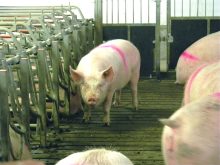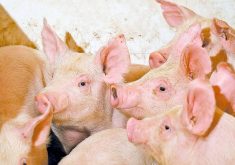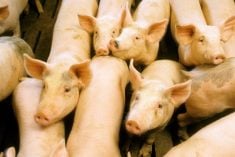A pandemic, inflation and the Russia invasion of Ukraine are creating a waterfall effect on global commodities.
“The real story of this war is unwinding globalism. Who goes without? It’s not just grain. Who goes without energy, without fertilizer?” said Brett Stuart of Global AgriTrends. “Even meat – we’ve got a smaller global beef cow herd and smaller global sow herd this year than last.”
Why it matters: The pork industry faces several threats, says a market watcher, and producers are well advised to consider their options.
Read Also

Jennifer Hayes appointed for second term as the Chairperson of the Canadian Dairy Commission
Jennifer Hayes has been re-appointed as Chairperson of the Canadian Dairy Commission by Heath MacDonald, Minister of Agriculture and Agri-Food.
A few years ago, tracking the pulse of global markets was hardly cause for a rapid heartbeat. Now, uncertainty and volatility keep Stuart hopping from week to week, he told attendees at Ontario Pork’s annual general meeting late last month.
“Whatever your business is, you have to start looking way out in front and saying, ‘OK, what do I have that could wreck me here, and how do I try and mitigate risk’? Try to be nimble, adapt and adjust to changing markets.”
Expect to pay insurance premiums, whether for actual insurance or investment in a stockpile of farm equipment parts to avoid weeks-long supply delays.
“It just comes down to, how do I not just try to make money this year? How do I survive so I can be in business next year?” Stuart said.
While he doesn’t expect to see a textbook recession next year, there will be consumer pushback to increasing costs. Shoppers are already pulling back on spending, which will impact pork markets.
The biggest macro-economic experiment in world history has played out in the United States during the pandemic, he said. Now inflation and the Russian-Ukraine war are raising the stakes.
Unlike the 1970s and 1980s, interest rates won’t rise high enough to curtail inflation, nor can governments claw back the 40 per cent money supply increase since 2019, he said.
“We’re in uncharted water … where we no longer have the ability to break inflation. Inflation is going to run, and fortunately in agriculture – in the hog sector – we may be in a spot where we can keep up with it a little bit.”
Food inflation is shifting global food policies. Argentina has introduced export quotas and food price freezes and Brazil has reduced tariffs on 87 per cent of goods and services by 10 per cent until Dec. 31. India has lowered edible oil tariffs and Malaysia introduced a maximum price control scheme covering 12 essential foods.
India booked the biggest soy oil shipment in U.S. history, Taiwan cut beef tariffs, China released food from its strategic reserve and the Philippines reduced food import taxes.
Russia and Ukraine account for a quarter of global grains trade and North Africa and the Middle East are heavily dependent on them for grains.
“We’re going to see countries turn over. We’re going to see tragedy and destitution in the third world over this,” Stuart said. “The biggest losers in this are the world’s poor.”
He said 68 countries, among the poorest in the world, import more than 90 per cent of their wheat. So, if prices rise by $4 a bushel, third-world wheat prices will increase by 100 per cent.
Ukraine is the fourth largest corn exporter globally. If there is no cease-fire, most of the corn won’t be planted in April. The war has already disabled elevators and eliminated corn buyers, cash bids, seed deliveries, fertilizer, fuel and labour access because most workers are fighting.
This month is critical for the Russia-Ukraine war, and unless there is a cease-fire that holds, it will further damage the global corn supplies and edge the third world towards instability,” said Stuart.
“Think about how much corn isn’t going to be planted in Ukraine if this continues here for another month,” he said. “So, we lose a crop from the fourth biggest exporter or the majority of that crop. Watch out.”
In 2022 there are fewer sows, which could help producers weather inflation. However, Stuart said that as global meat supplies tighten and China’s diversification pool is drained, China can’t buy corn from Ukraine and move away from the U.S.
He suspects something is afoot in China where corn and soymeal prices have increased and the hog sector has lost money for eight consecutive months.
“I think their production and inventories are lower than what they’ve been telling us,” he said. “Feed costs have gone through the roof. Hog prices are terrible. The top 10 companies in China lost $79 billion farming hogs last year – $79 billion. Those guys represent nine per cent of the national herd.”
He believes the China pork market has fundamentally changed, with cheap imported pork carving a place in the market.
“Man, nobody rode the roller coaster like you (Canadian) guys did. I mean from lots of pork to China to zero pork to China to lots of pork to China to delistings again,” Stuart said. “That’s hard to manage. But today, it’s pretty much closed.”
Fertilizer is another significant concern globally. Prices doubled between Jan. 21 and March 22.
“We’re probably going to be OK. Now, I’m not saying it’s going to be cheap. I’m just saying we’re going to be able to find it,” said Stuart. “While we’re on the topic of big scary things, the West Coast port workers union contract expires July 1, 2022.”
Stuart said the longshoreman’s union holds the U.S. economy in a vise grip because the west coast ports handle most products entering the country. The sticking point is the union’s demand that ports not automate because it will result in a loss of high-paying jobs for members.
The last negotiation in 2015 destroyed U.S. chilled pork exports with port delays to Japan. A strike could cause enormous demand for chilled pork loins from Canada to Japan overnight if the U.S. can’t fulfil orders.
“That gives you an indication of how much leverage they have,” he said, adding that longshoremen walk off the job, the ports would shut down and the U.S. economy would grind to a halt.
Additionally, African swine fever on the doorstep of North America is another threat. If ASF is detected, what happens to five million feeder pigs if the U.S. market is near zero and Canadian prices go through the roof because the U.S. is out of Japan? If Canada is regionalized and U.S. pork is open regionally, with 25 per cent too much pork and high Canadian prices, how does that shake out, Stuart asked.
“Just be aware. I don’t know the risk. I don’t know the probability. It is a ticking time bomb. There’s no vaccine, and it’s still bouncing around the Caribbean. So, hopefully, it’s a long timeline.”
Despite current uncertainty, Stuart said the 2022 pork export forecast for the U.S. shows China and Hong Kong exports are down, Mexico’s are up and all others are relatively steady.
His bold long-term forecast is that global pork demand will outstrip supply in the next decade.
“I think there’s good news ahead, good days ahead,” he said. “I’ll leave you with this quote, ‘Don’t bet on the end of the world. It only happens once, and the odds are really against it.”












